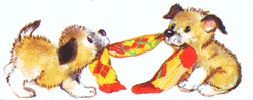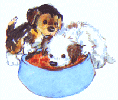How to care for your puppy after a hypoglycemic incident. Every puppy responds differently after a sugar low. The sooner they are treated at the onset of symptoms, the faster they will bounce back. Many pups are back to their own selves running around playing in a few minutes or a few hours after an attack. But if your puppy has had a very severe case or was almost comatose before treatment, it could take several hours and even as much as several days for your puppy to be back to normal. Remember low blood sugar causes their tiny bodies to totally shut down, so many pups act very weak or depressed or groggy and some will not eat on their own after a severe attack. To help your puppy recuperate: 1. It is very important to make sure that they get food in their stomach to prevent them from going into hypoglycemia again. If they are not eating on their own, you must hand feed them. We use a few teaspoons of Gerber strained beef, chicken or turkey all meat baby food, a few drops of water and about a two inch strip of nutri-cal in a small cup; microwave for 10-20 seconds or so until the Nutri-Cal® melts, stir and give 3-6 cc's by mouth with a syringe or eye dropper. If your puppy is not eating on his own, repeat every 2 to 4 hours until he will take food himself. There is also a terrific new product out called Rebound® Liquid Diet it is a liquid diet that is totally nutritionally complete and is great as an added supplement for hypoglycemic pups that are not eating well! 2. Keep your puppy warm. When a puppy has low blood sugar, their temperature drops very low. It is important to gradually warm your pet and wrap them in a towel or put them on a low temperature heating pad until they are well enough to keep their own temperature up. 3. You might want to visit your veterinarian and have a stool sample done on your puppy to rule out worms, coccidiosis and /or Giardia. These things can run a puppies system down and cause an otherwise healthy pup to not eat well or go into hypoglycemia. Sometimes, puppies that are prone to attacks of hypoglycemia can also have an undiagnosed bacterial or parasitic infection. If this is the case, then usually once they are put on antibiotics such as Albon, Amoxicillan, or Flagyl either alone or in combination and the infection is cleared up, they may never have another hypoglycemic attack. IMPORTANT: Never worm a sick or hypoglycemic puppy as it can be fatal!! Also Fenbendazole wormer (Panacur, safeguard) is never a good alternative to flagyl in treating giarrdia in a teacup or hypoglycemic puppy. While Fenbendazole is a great product and is usually a very safe and effective wormer and an easy giardia treatment for most puppies, it has caused several deaths in teacup and hypoglycemic puppies when used as a giardia treatment!!! We recommend giving your new puppy a 1/4 to 1/2 of a teaspoon of vanilla flavored yogurt (must contain live culture) once or twice a day for the first week or two. Not only does the yogurt taste good and give them extra nutrition, the good bacteria it contains can help prevent problems and sometimes even cure or prevent bacterial infections that can arise from the stress of going to a new home. |
to Sharmin's Toy Poodles |
These tips are for the first few weeks, to help your new pup to adjust! |
1. The most important rule, is to always have food & water available for your puppy at all times! Due to their small size, teacups must replenish their energy more frequently than larger size puppies. The only way to do this, is by supplying plenty of nourishment in the form of food. You must remember that puppies only eat very small amounts of food at a time but they exert large amounts of energy. Also, do not change the puppies food for the first 2 weeks until the puppy has adjusted to it's new home. Then, if you are going to make a change, do it gradually by slowly adding more of the new food to the old food each day until they are totally switched over to the new food. |
2. The next most important rule, is to have a baby or puppy playpen or some other type of small enclosed area to keep your T-cup confined in, when you are not playing with them. This must be a small area with enough room for their bed and easy access to food and water where they can rest and eat in peace. This area should be no larger than 3ft x 4ft if at all possible. (We use a 2ft x 3ft baby playpen.) Never give your teacup puppy the run of the whole house until they are at least 5 or 6 months old. With such a large space to run around in, it is too easy for them to tire and lose track of where their food is. This could lead to hypoglycemia or death. |
3. For the first few weeks, do not let your T-cup out to play for longer than a one hour period at a time. Play with them for a short time, then give them a small dose of Nutri-Cal® or karo syrup and then place them back in their playpen so they can eat and rest. Remember that they are very tiny babies and tire easily. Please be careful not to over-tire your puppy especially in the first few weeks. A puppy will play until it drops. It may play so much that it is too tired to eat. It is up to you as the owner to be responsible and see that your puppy gets enough rest. Most very small puppies need as much as 20 out of 24 hours rest. Be especially aware of the amount of time children play with the puppy. These are babies and must be treated as such. |
4. *Hypoglycemia, or low blood sugar can be deadly to your puppy! It is a problem that affects many toy breeds of puppies usually between the age of 5-20 weeks of age. All owners of small dogs should be on the lookout for it! The best preventative for this, is to have a tube of Nutri-Cal® or Nutri-Stat® on hand. It is an extremely good source of food and vitamins. It is also one of the best preventatives and/or cures for keeping your puppy from going into hypoglycemia. It is important for at least the first week or so, to remember to give your puppy a little bit (1 inch strip) of Nutri-Cal® or Nutri-Stat® in the morning and in the evening. Also, if they have been out playing for a while, or have had a lot of people carrying them around or have been away from a food source for a prolonged period of time, give them a tiny bit before retiring them to their playpen. ( We recommend nutri-cal over honey as honey brings the blood sugar up for a short period of time, but then the blood sugar tends to plummet again. Nutri-cal has a food source combined with sweeteners which keeps the blood sugar more stable for a longer period of time. Also, too much honey tends to rot the teeth) |
5. Always make sure that you have a firm grip on your puppy at all times when it is off the ground. Many fatalities or broken bones have been caused by a tiny dog wriggling out of an owners grasp, or jumping off a lap, couch, or bed, and breaking their neck, legs, or landing on their head. Always supervise small children when around or handling a small dog. The only safe way for a child to hold a small dog, is sitting on the floor with the puppy between their legs, or on their lap. Also, never leave a small puppy on a chair, bed, couch, or stairs unattended. Remember, a fall from as low as two feet high can be fatal! |
6. Never ever leave your teacup unattended unless it is in it's playpen or a safe enclosure! There are many places that such a tiny dog can manage to fit in, and disappear from, not to mention get stuck under! Also such innocent things as a book or telephone falling on them can break a bone or be deadly! |
IMPORTANT! PLEASE READ IF YOU ARE CONSIDERING BUYING A TEACUP OF ANY BREED OF DOG. |

* Symptoms of hypoglycemia. Hypoglycemia can occur without warning to any healthy puppy and can be a very scary thing! So it is best to know what to look for! Your puppy may exhibit one or more of these signs: The first sign that is usually seen, is vomiting on an *empty stomach. (*clear liquid or bile) If your teacup has not eaten in awhile, and vomits without acting sick. Give them food, Nutri-Cal® or karo syrup immediately! Some other signs are: acting listless, weak, tired, sometimes walking with an unsteady gait as if drunk, shakiness, falling over, stiffening up, laying on their side paddling with their feet and being unable to get up, and in very severe advanced cases, laying on their side and being totally unresponsive or comatose. If your puppy becomes hypoglycemic, it is very important that you react IMMEDIATELY!! If the puppy is not given some quick form of nutrition containing sugar i.e. nutri-cal, honey, sugar, glucose, karo syrup or any sugar containing product to raise the blood sugar immediately, coma, brain damage and/or possibly death could result. If any of these symptoms occur, give the puppy a small dose of either nutri-cal, honey, sugar, glucose, karo syrup, pancake syrup or any sugar containing product that is handy. Time is of the essence, so reach for whatever is the closest at the moment. (DO NOT USE artificial sweetners such as Nutrisweet, Splenda etc. as they will not work!) If the puppy is unable to swallow, do not force liquids down it's throat as it can get into the lungs and cause asphyxiation. If the puppy is too weak to swallow and take the honey or nutri-cal on it's own, put it on your finger and rub it on the roof of his mouth. If necessary, pry his mouth open but just make sure that he gets it. HIS LIFE DEPENDS ON IT!! It may be necessary to give several doses. (I like to keep a product called Pet nutri-drops on hand. It allows nutrients to bypass digestion and be absorbed directly into the bloodstream. Very handy if a puppy is too unresponsive to swallow on his own.) After being given something sweet, your puppy should show some type of improvement and be more alert and responsive within 10-15 minutes. After your puppy feels a little better, remember to give him/her a protein based meal (any good meat based dog food or all meat babyfood will do) to level out it's blood sugar. |
*Hypoglycemia , or low blood sugar (sometimes called "sugar shock") is a condition where the blood sugar level drops to an extremely low level, usually due to lack of food, or by using up all stored energy without it being replenished. (Such as when your puppy plays for an extended period of time without eating.) Teacups can be prone to hypoglycemia because they have such tiny digestive systems. They can only store a small amount of food (energy) in their bodies at one time. Their liver and pancreas which are necessary for digestion and sugar balance are also small and usually underdeveloped as well. This is why most puppies tend to grow out of hypoglycemia as they get older. As they grow, so do their major organs. This makes them more able to utilize and process the food that they eat so it can sustain them for longer periods of time. Also, other common triggers are stress (such as going to a new home) or bacterial infections or coccidiosis. (Coccidiosis is a protozoan infection that most puppy and adult dogs carry, but can lie dormant and cause no problems until in a stressful situation.) When a puppy is exposed to stress, and/or not getting proper nutrition, Coccidiosis can rapidly multiply in the intestinal track and cause illness, making hypoglycemia worse. This is why many breeders and vets have been stumped as to how an otherwise healthy puppy, with a negative fecal exam, can suddenly develop coccidiosis only a few days after going to a new home. Because of this, having a stool sample analyzed by your vet can be a good idea if you are having a problem with hypoglycemia in your new puppy. Most puppies have hypoglycemia just due to their small size, but hypoglycemia can also be a hereditary condition. The hereditary form is due to an inability to process sugar properly. It tends to run in certain bloodlines more than others. While most puppies grow out of the threat of hypoglycemia as they get older, the hereditary type can also effect larger pups or last into adulthood. REMEMBER: to prevent hypoglycemia, puppies need to eat several small meals a day. It is much easier to prevent Hypoglycemia, by always providing a readily available food supply, than to have to treat it once it happens. It is very scary to see a puppy that you love so dearly in "sugar shock." |

to Sharmin's Toy Poodles |
1998-2008 Sharmin's Toy poodles. All pictures and printed data in this website are the exclusive right of Sharmin's Toy Poodles and may not be altered, copied, distributed or otherwise used without our written consent. |
How to care for your puppy after a hypoglycemic incident. Every puppy responds differently after a sugar low. The sooner they are treated at the onset of symptoms, the faster they will bounce back. Many pups are back to their own selves running around playing in a few minutes or a few hours after an attack. But if your puppy has had a very severe case or was almost comatose before treatment, it could take several hours and even as much as several days for your puppy to be back to normal. Remember low blood sugar causes their tiny bodies to totally shut down, so many pups act very weak or depressed or groggy and some will not eat on their own after a severe attack. To help your puppy recuperate: 1. It is very important to make sure that they get food in their stomach to prevent them from going into hypoglycemia again. If they are not eating on their own, you must hand feed them. We use a few teaspoons of Gerber strained beef, chicken or turkey all meat baby food, a few drops of water and about a two inch strip of nutri-cal in a small cup; microwave for 10-20 seconds or so until the Nutri-Cal® melts, stir and give 3-6 cc's by mouth with a syringe or eye dropper. If your puppy is not eating on his own, repeat every 2 to 4 hours until he will take food himself. There is also a terrific new product out called Rebound® Liquid Diet it is a liquid diet that is totally nutritionally complete and is great as an added supplement for hypoglycemic pups that are not eating well! 2. Keep your puppy warm. When a puppy has low blood sugar, their temperature drops very low. It is important to gradually warm your pet and wrap them in a towel or put them on a low temperature heating pad until they are well enough to keep their own temperature up. 3. You might want to visit your veterinarian and have a stool sample done on your puppy to rule out worms, coccidiosis and /or Giardia. These things can run a puppies system down and cause an otherwise healthy pup to not eat well or go into hypoglycemia. Sometimes, puppies that are prone to attacks of hypoglycemia can also have an undiagnosed bacterial or parasitic infection. If this is the case, then usually once they are put on antibiotics such as Albon, Amoxicillan, or Flagyl either alone or in combination and the infection is cleared up, they may never have another hypoglycemic attack. IMPORTANT: Never worm a sick or hypoglycemic puppy as it can be fatal!! Also Fenbendazole wormer (Panacur, safeguard) is never a good alternative to flagyl in treating giarrdia in a teacup or hypoglycemic puppy. While Fenbendazole is a great product and is usually a very safe and effective wormer and an easy giardia treatment for most puppies, it has caused several deaths in teacup and hypoglycemic puppies when used as a giardia treatment!!! We recommend giving your new puppy a 1/4 to 1/2 of a teaspoon of vanilla flavored yogurt (must contain live culture) once or twice a day for the first week or two. Not only does the yogurt taste good and give them extra nutrition, the good bacteria it contains can help prevent problems and sometimes even cure or prevent bacterial infections that can arise from the stress of going to a new home. |
IMPORTANT! If your puppy does not respond with any improvement at all to the sugar that you have fed him within 10-15 minutes, or appears comatose or unresponsive, take him immediately to the closest veterinarian! In severe cases, if their blood sugar has dropped too far, it is sometimes necessary for them to receive glucose (dextrose) given by an subcutaneous shot or in very extreme cases by IV (intravenous). Make sure that you tell your vet that you suspect that your puppy is in hypoglycemia and specifically ask for a shot of Dextrose before he does anything else. Unfortunately, many veterinarians are not familiar with treating tiny dogs and/or have never seen a case of hypoglycemia and many puppies have died needlessly while the vet wastes precious time performing routine tests looking for other things. THIS IS VERY IMPORTANT TO DO AS IT COULD MEAN THE DIFFERENCE BETWEEN LIFE OR DEATH FOR YOUR PUPPY!! REMEMBER: Every minute counts!! Before going out the door to the vets, make sure and give some honey, Nutri-Cal® or karo syrup to your puppy (if he is comotose or unresponsive do not give liquids that he can choke on as he won't be able to swallow. Instead rub a coating of honey or Nutri-Cal® around in his tongue and mouth). |
What is Hypoglycemia? |
Symptoms and Treatment |
After Care |
We hope these tips help you and your new puppy enjoy a long healthy life together! A note to other Breeders: No portion of this page can be reproduced or copied without permission, but please feel free to link to this page if you would like. |

REMEMBER this is a very traumatic time for your puppy! It has been taken away from it's mom and brothers and sisters and brought to a totally new home with strangers. So it is very important that you try and make the first week to 2 weeks with your new puppy as calm of an experience as possible. It is an important time for the puppy to bond with you as it's new family and to get used to it's new environment. PLEASE resist the urge to take your puppy to the workplace or to visit friends, and relatives during this period. Also keep handling by children to a minimum. |
Sever cases of Hypoglycemia |
Most puppies respond well to frequent meals and Nutri-Cal® several times a day, but occasionally a puppy will come along that is a real challenge. They just repeatedly keep going into hypoglycemia no matter how well they are cared for. (These are for extreme cases only, as repeated use of sugary substances can lead to tooth rot and bad breathe.) Here are some tips to try that might or might not work for you depending on your individual situation. Some of these we have tried, and some we haven't tried personally, but were recommeded to us by other breeders, veterinarians or owners. If you have any suggestions or tips that have worked for you, please e-mail us so that we may add them to our list. |
1. Add a small amount of clear Karo syrup to their drinking water and keep this water in front of them at all times. Puppies usually drink frequently and every time they take a drink of water they will be getting a small amount of sugar to keep their blood sugar up. Clear Karo syrup is our choice, as it seems to keep fresh in the water the longest. 2. Other alternatives to Karo syrup that are also used in the drinking water are, honey or gatorade. Some breeders use Children's Pedialite mixed 1/2 and 1/2 with regular tap water. We have also heard of using Knox gelatin capsules in the water to add a bit of protein along with the Karo syrup or honey. Protein is good for keeping the blood sugar at a more stable level (but use caution and do not use too much, because too much protein can be hard on the kidneys.) Remember, when adding anything to the drinking water, don't overdo it! The point is to get the puppy to drink it. If the drinking water becomes cloudy or tastes terrible, your puppy won't drink it which can lead to dehydration and even bigger problems. |
3. SWEET TREATS. I have also heard of giving puppies marshmallows or mini marshmallows as a treat to chew on. They are almost total sugar so it makes sense. The breeder that I talked to that uses them, leaves the marshmallows out of the package for a day or so to harden them a bit. (This makes them a bit chewier so they last longer). Then she leaves a couple of them in their pen at all times. It gives them something fun to chew on and they get a bit of sugar pick me up in each bite. Several people have written in that they also use breakfast cereal such as Honey Nut Cheerios or Captain Crunch. Not only do they contain sugar but also contain some nutritional value too! They either mix these with their regular food or just leave them in their pen as a treat to chew on. (remember though, not to use any cereal that contains chocolate or is very high in salt, as they can both be toxic to dogs! ) |
We will add more hints as they become available!! (Due to time restrictions I might not always be able to answer everyone's e-mails but I always read and enjoy them and will pass any helpful tips along.) PLEASE keep the hints coming in, as your tips really do make the difference in saving many little ones lives!!! (We receive many letters a week telling us how this page has saved their teacup or tiny dog's life. So your help does count! Thank you!) |




Teacup Care |
& hypoglycemia information |


